League Of Olympic Swim Legends: Duke Kahanamoku Tops 100 Free Podium With Weissmuller & Popov
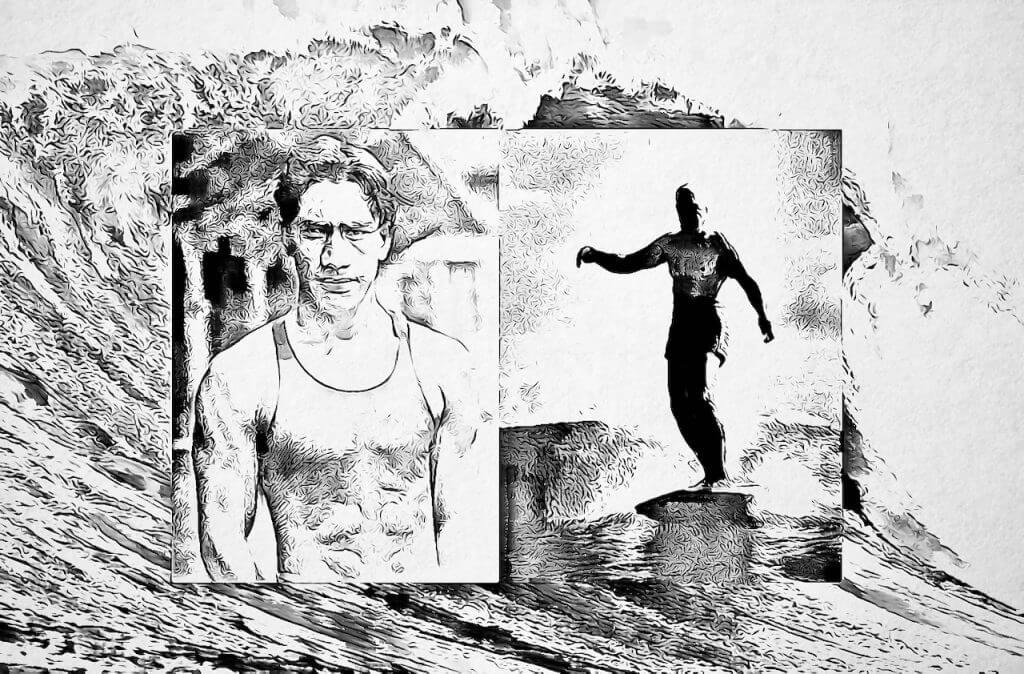
What would have unfolded had Tokyo 2020 gone ahead as planned this week – and where would it all have fit in the thread of Olympic swim legends and pioneers like Duke Kahanamoku, Johnny Weissmuller and Alex Popov? To mark the eight days over which the Tokyo 2020 Olympic Games would have unfolded had the coronavirus pandemic not forced postponement, the team at Swimming World is filling the void with a Virtual Vision Form Guide and League of Olympic Swimming Legends.
Day 5, event 4 – Father of Surf & Tarzan take the race to modern-era back-to-backers
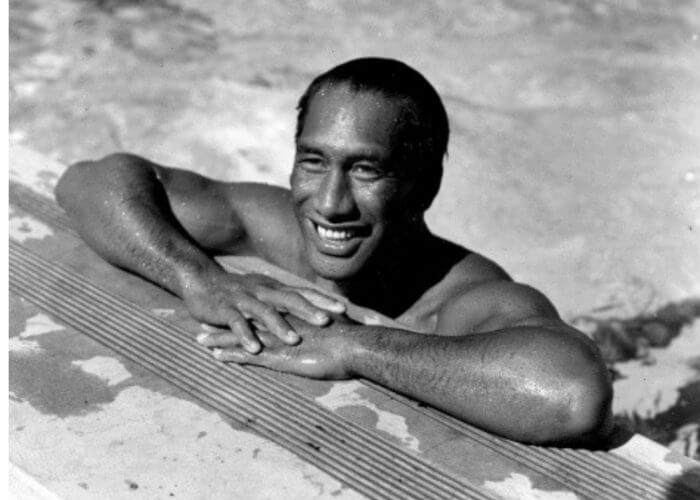
Duke Kahanamoku. Photo Courtesy: International Swimming Hall of Fame (ISHOF)
Men’s 100m Freestyle
The Podium
- Duke Kahanamoku (USA)
- Johnny Weissmuller (USA)
- Alex Popov (RUS)
The Other Finalists (Listed Alphabetically):
- Matt Biondi (USA)
- Charlie Daniels (USA)
- Mark Spitz (USA)
- Pieter van den Hoogenband (NED)
- Michael Wenden (AUS)
- Our Lane 9* place is extended to three Olympic-record setters, who must race off to take a plea in our showdown: two are here because the naked eye and judgement of humans overrode the clear evidence of the timing system at their disposal; the other is here because he might have been in the club of the double champions on the podium had boycott not blocked his way to Moscow. History will not be changed but for our exercise, may the best man win a swim-off to be decided by timing pad:
- John Devitt (AUS) ; Lance Larson (USA); and Rowdy Gaines (USA)
* – in our series, we will use Lane 9 to add an athlete whose story reflects extraordinary situations of different kinds, including being deprived by those who fell foul of anti-doping rules or by political decisions or, indeed the Olympic program, as well as simple facts such as “he/she was the only other title winner who claimed gold in a WR but didn’t make out top 8 on points”
All-Time Battle Of Olympic Swim Legends Goes To Duke Kahanamoku
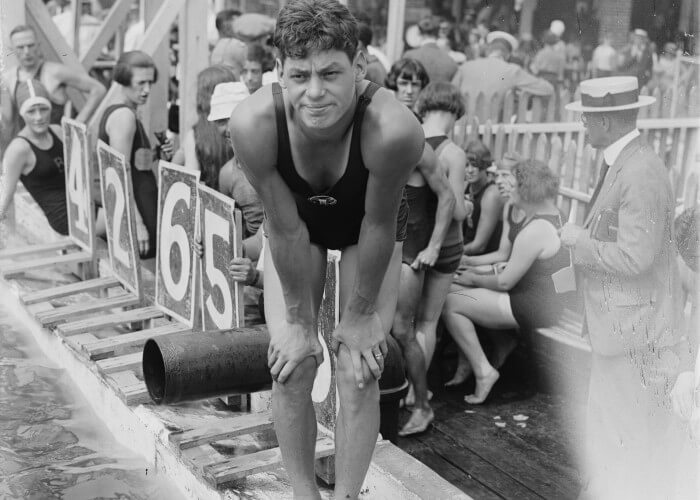
Johnny Weissmuller – Photo Courtesy: ISHOF
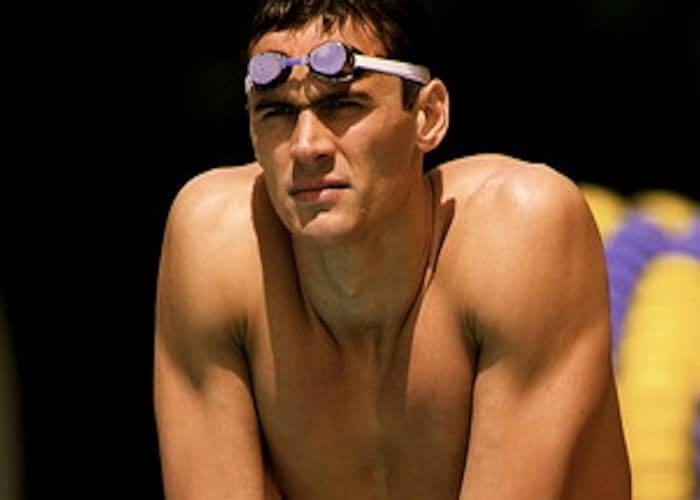
Alex Popov. Photo Courtesy: Patrick B. Kraemer
The 100 freestyle has long been the blue-ribbon event in the sport, the list of past Olympic champions a Who’s-Who of greats. For all the stars who have chased gold in this event, it is interesting to note that there have been four repeat champions on the Olympic stage. What does that mean? One of those men is left off the Legends podium.
In the early 1900s, two names stood out in the sport, Americans Duke Kahanamoku and Johnny Weissmuller. Both also happened to go on to acclaim beyond the pool, Kahanamoku as the Father of Surfing and Weissmuller as Tarzan on the silver screen. In this race of Legends, it was Kahanamoku and Weissmuller who won gold and silver, respectively.
A three-time world-record holder, Kahanamoku prevailed in the 100 freestyle at the 1912 and 1920 Olympics, and had World Ward I not canceled the 1916 Games, a third crown was likely. Meanwhile, Duke Kahanamoku added silver in 1924, when Weissmuller claimed his first Olympic title, which was followed by another gold in 1928. Weissmuller was also the first man to break the minute barrier in the event, accomplishing the feat in 1922.
The duel for the bronze medal came down to Russia’s Alexander Popov (1992/1996) and the Netherlands’ Pieter van den Hoogenband (2000/2004), both two-time Olympic champions. Popov got the edge behind his silver medal in 2000, which made him a rare individual to medal in the same event at three consecutive Games.
Duke Kahanamoku – Olympic Sprint Champion & The Father Of Surf
The Hungarian Breaststroke Used By Mike Barrowman:
1920 Antwerp – Men 100m Freestyle – Athletes: 31, Nations: 15
- 1:00.4wr Duke Kahanamoku USA
- 1:02.2 Pua Kela Kealoha USA
- 1:03.2 William Harris USA
- 1:03.8 William Herald AUS
- DQ Norman Ross USA
Date of final: August 29, 1920
In spite of inclement weather, crowds flocked to the outdoor ‘pool’ in Antwerp to get a glimpse of triumphant Hawaiians Duke Kahanamoku and brothers Pua Kela Kealoha and Warren Paoa Kealoha, and the double-gold distance freestyle champion Norman Ross.
Kahanamoku won the 1912 title thanks to an act of great sportsmanship from Australian Cecil Healy – and then in 1920 he retained the 100m freestyle crown – twice. The first final, on August 24 and won in a world record of 1:00.4, had to be reswum after William Herald, of Australia and the only non-American in the final, claimed that Ross had fouled him. Ross was disqualified but the next day ploughed his frustration into winning the 1,500m title in 22:23.2, and the 400m crown three days later, in 5:26.8.
Ross, who emerged from the Great War with honours, went on to become a leading US sports broadcaster and was America’s first classical music disc jockey. He also had a reputation as a showman. Once when training in Lake Michigan, he swam close to shore and shouted to sunbathers:
“Is this Milwaukee?” When the shocked onlookers replied “No, it’s Chicago!”, Ross said: “Nuts! I must have missed my turn.”
Back in Antwerp, that second 100m final, on August 29, produced an identical result: Kahanamoku, in 1:01.4, led teammates Pua Kela Kealoha (1:02.6) and William Harris (1:03.0) to the podium, while Herald took the wooden spoon in 1:03.8.
Perry McGillivray, Pua Kela Kealoha, Ross and Kahanamoku set a world record of 10:04.4 in a 4x200m freestyle relay that saw Henry Taylor, winner of three gold medals in 1908, bring his career to an end with a bronze alongside his Britain teammates that took his career tally to what remains an Olympic record in Britain: four gold, one silver, three bronze. As one legend waved farewell, another was popping his head above the waves: last man in for the Sweden team that finished fourth was 19-year-old Arne Borg, 1924 medal winner and 1928 Olympic champion over 1,500m.
Duke Kahanamoku – Gold – Antwerp 1920
The Advent Of Johnny Weissmuller As King Of Sprint
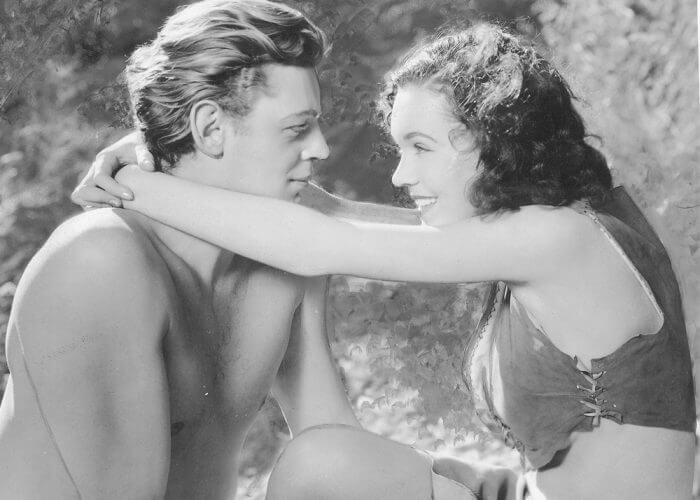
From Swimming World July 2020 – Takeoff To Tokyo Series – Johnny Weissmuller – A Star of Swimming And Hollywood – With Maureen O Sullivan
1924 Paris – Men 100m Freestyle – Athletes: 30 Nations: 15
- 59.0or Johnny Weissmuller USA
- 1:01.4 Duke Kahanamoku USA
- 1:01.8 Samuel Kahanamoku USA
1:02.0 Arne Borg SWE
1:03.0 Katsuo Takaishi JPN
DNS Orvar Trolle SWE
Date of final: July 20, 1924
Johnny Weissmuller (USA) was born on June 2, 1904, in Freidorf, then a part of the Austrian-Hungarian Empire, but today a district in Timisoara, Romania. He grew up to be the greatest male swimmer of the first half of the 20th century.
At 10 years of age he joined the Stanton Park Pool swim team and won every race he entered. Later in his teenage years he joined the local YMCA and eventually came to the attention of Bill Bachrach, coach of the Illinois Athletic Club, two-time US Olympic coach and mentor to the likes of Sybil Bauer, Arne Borg, Harry Hebner, Ethel Lackie and Norman Ross.
Under Bachrach’s tutelage, Weissmuller refined his stroke and increased his strength and conditioning. On July 9, 1922 – just one month after his 18th birthday – Weissmuller became the first man to swim 100m freestyle under a minute when he clocked 58.6 in a salt water pool in Alameda, California, sending the world record of one minute flat held by Duke Kahanamoku to a bygone era. It was the first of 67 world records he set in races from 50yd to half a mile over.
At the 1924 Olympic Games in Paris, 20-year-old Weissmuller was the overwhelming favourite to wrest Kahanamoku’s crown from the Hawaiian. According to records at the International Swimming Hall of Fame, Kahanamoku turned to Weissmuller, teammate, rival and pretender to the crown, before the start and said:
“Johnny, good luck. The most important thing in this race is to get the American flag up there three times. Let’s do it!”
And so they did, with the help of the defending champion’s younger brother Samuel.
Weissmuller led from start to finish, turning at the 50m mark in 27.6 ahead of Sweden’s Borg and Kahanamoku and his brother Sam on his way to winning his first Olympic crown in 59.0 (Olympic record inside the 1:00.4 of Kahanamoku from 1920). Kahanamoku, the 34-year-old defending champion who first claimed the 1912 crown in Stockholm, was second, while Sam gave the USA a clean sweep as he locked Borg off the podium by 0.2sec.
After Weissmuller had gone off to the locker room, he heard a wall of noise: the crowd of 7,000 had stood to its feet as every voice called for their hero to return. Organisers had to announce that the champion would reappear later in the day. During the Games, Weissmuller delighted spectators by performing a regular comedy diving act with teammate Stubby Kruger in between races. Weissmuller also won gold medals in the 400m freestyle and the 4x200m freestyle in Paris.
Another Great race in Olympic 100m Freestyle History
How Popov Handed Over the Crown In Style, With Silver At The Third Time Of Asking After Two Golds
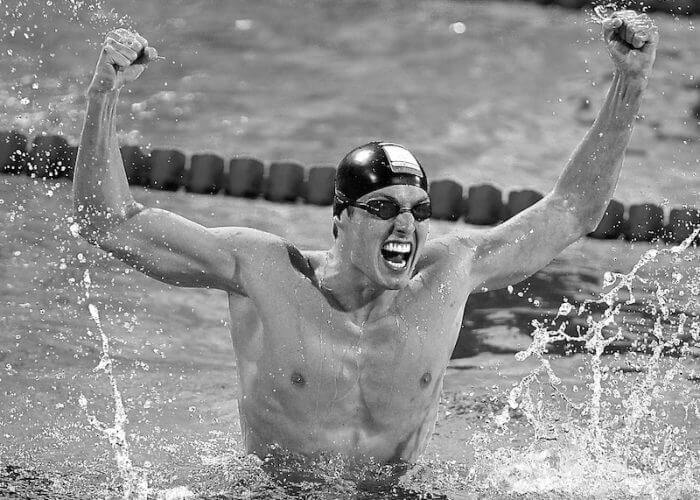
Pieter Van Den Hoogenband – Photo Courtesy: Patrick B. Kraemer ©
2000 Sydney – Men 100m Freestyle – Athletes: 73 Nations: 66
- 48.30 Pieter vd Hoogenband NED
- 48.69 Alexander Popov RUS
- 48.73 Gary Hall USA
48.74 Michael Klim AUS
49.09 Neil Walker USA
49.22 Lars Frolander SWE
49.36 Denis Pimankov RUS
49.44 Chris Fydler AUS
Date of final: September 20, 2000
You can read about Alex Popov’s exploits in our recent anniversary celebration of his 50m freestyle record. A champion is also defined by what happens when gold proves elusive.
At Homebush, Sydney, on September 17, 2000, Pieter van den Hoogenband shaved 0.16sec off Thorpe’s world record in the semi-final of the 200m and matched the time to beat the home hero by 0.48sec in the final. Approaching the 100m, his eye was on the 48.18 world record that had been established by Michael Klim leading the Dolphins to an upset victory over the USA in the 4x100m freestyle on a thrilling opening night in the pool at Homebush.
In the second semi-final, after watching Klim and Alex Popov clock 48.80 and 48.84 in the first, Van den Hoogenband made the sort of history that draws gasps from unsuspecting crowds: he raced into lane four of the 100m final with the first sub-48sec effort – of 47.84. The next day he took the crown in 48.30 to Popov’s 48.69, with Gary Hall Jr on 48.73, just 0.01sec ahead of Klim. The race for the podium was the tightest in history.
In 2004, Popov did not make the final, locked out by Ian Thorpe, the Australian who qualified last on the way to taking bronze as the first man ever to make the medals over 100, 200 and 400m at the Olympic Games. At the helm of the 100m was Van den Hoogenband, dreaming of his third go.
In 2008, despite the advent of a new generation of sprinters, the Dutchman said that he was “still working on his dream of winning the three in a row” – and with a new fan in tow: he and wife Minouche Smit, a former Dutch international, celebrated the birth of daughter Daphne in June 2006.
Had he made it, Beijing 2008 would have placed him atop our All-time podium as the first man to join the Triple Crown club after Dawn Fraser (100m free, 1956-64) and Krisztina Egerszegi (200m back, 1988-96). We will never know what might have happened had the shiny suits not been allowed to make it to Olympic waters, the skew and blur of them ended with a ban on non-textile race garments from January 1, 2010. What we do know is that Hoogie was 5th in a final that has not yet been matched since when it comes to the range of speed 1st to 8th.
A footnote to the 100m freestyle in 2000 – Eric The Eel
The speed of the elite stood in stark contrast to a man who became famous for resting at the bottom of the result sheet in heats of the event. Eric Moussambani, of Equatorial Guinea, found himself the lone swimmer of his heat in 1:52.72 after Karin Bare, of Niger, and Farkhod Oripov, of Tajikistan, were removed for false-starting. Named “Eric the Eel” by the Craig Lord, Moussambani turned at the 50m mark in 40.97. He looked as though he might not make it as lifeguards stood by. After his race, Eric waved to the crowd shyly before heading for the locker room, where he broke down in tears. As Matt Busby, the legendary coach to Manchester United Football Club once said:
“If you think it’s tough at the top, you want to try being at the bottom”.
The next day in Sydney, Moussambani found himself one of the biggest characters at the Games, his tale told far and wide across the globe. As noted in The Times in London when Eric The Eel was first mentioned, his 1:52 over 100m would have allowed Thorpe, Hoogie and the rest to get home in the 200m final, acknowledge the crowd and cheer Eric home after two exhausting lengths.
He was not to be deterred: by the 2001 World Championships, Moussambani improved to a 31.88sec effort in the 50m freestyle. The International Olympic Committee then imposed a standard that all had to achieve if they wanted to swim at the Olympic Games, the stories of Eddie The Eagle, Eric the Eel and others fun but annoying if you happen to be world class but left at home because you were third American home at Trials, possibly still a World record holder and ranked 5th in the World that season, for example.
Here’s how the Sydney 2000 Fat-Arsed Wombat Crew commentated on it all:



